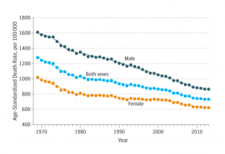
Courtesy of AMA: Age-Adjusted Death Rates, M/F.Total
A fairly detailed study published in the current JAMA explores the temporal trends of deaths in the United States between 1969 and 2013. It's mainly good news. The authors, led by Drs. Jiemin Ma and Ahmedin Jemal of the American Cancer Society, found an overall decreasing trend in the age-standardized death rate between 1969 and 2013 for all causes combined, and for diabetes, heart disease, cancer, stroke, unintentional injuries and diabetes.
However, the rate of decrease appears to have slowed for heart disease, stroke, and diabetes. All in all, a major salutary trend in public health has been quantitated by these authors.
The apparent slowing of the decline probably has much to do with the uptake of, and compliance with, health-preserving medications and behaviors, especially statin drugs and reducing smoking.
In contrast, the rate for chronic obstructive pulmonary disease COPD, chronic bronchitis and emphysema doubled over this period. However, this statement is far from being as clear-cut as it sounds. The COPD death rate was very high in 1969 due to the 40+ percent smoking rate among American adults at that time. The rate continued to climb, first among men then among women, even as smoking rates started their slow decline.
So the current "doubled" rate represents the following secular trends: while a decreasing trend was observed in men after 1999, the rate increased steadily for women from 1969 to 2013 and for men from 1969 to 1985. The rate started to wane among men between 1999 and 2013, probably because many men had quit smoking, which is a major risk factor for the disease. Smoking prevalence has now also decreased among women, and thus they will probably also have fewer COPD deaths in the coming decade.
The overall decrease in the death rate for unintentional injuries is mainly thanks to continuous declines in motor vehicle related deaths.
The observed recent attenuation in declining death rates for obesity-related diseases (eg, heart disease, stroke, and diabetes) may reflect the lagged consequences of increased obesity prevalence since the 1980s.
For death rates to come down even further will probably require more local programs that encourage healthy living in communities and for individuals, Dr. J. Michael McGinnis, a senior scholar at the National Academy of Medicine, said in an editorial in JAMA, which he discussed with CNN.
The current study did not capture a number of disturbing trends, such as the sharp rise in the prevalence of Alzheimer's disease (which has overtaken diabetes as the sixth leading cause of death) and the recent increase in diabetes deaths, added editorialist McGinnis. There are also many important measures of health besides death, such as quality of life and health care access, and in particular the gap in health care quality among whites and blacks, that need to be addressed in future studies.


